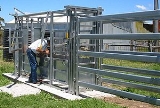
Cattle crush
Encyclopedia
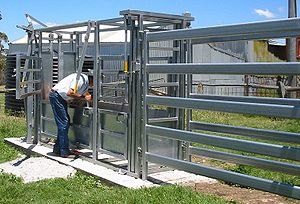
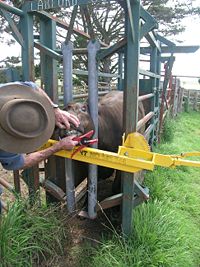
North America
North America is a continent wholly within the Northern Hemisphere and almost wholly within the Western Hemisphere. It is also considered a northern subcontinent of the Americas...
), standing stock, or simply stock (North America, Ireland
Ireland
Ireland is an island to the northwest of continental Europe. It is the third-largest island in Europe and the twentieth-largest island on Earth...
) is a strongly built stall or cage for holding cattle
Cattle
Cattle are the most common type of large domesticated ungulates. They are a prominent modern member of the subfamily Bovinae, are the most widespread species of the genus Bos, and are most commonly classified collectively as Bos primigenius...
, horse
Horse
The horse is one of two extant subspecies of Equus ferus, or the wild horse. It is a single-hooved mammal belonging to the taxonomic family Equidae. The horse has evolved over the past 45 to 55 million years from a small multi-toed creature into the large, single-toed animal of today...
s, or other livestock
Livestock
Livestock refers to one or more domesticated animals raised in an agricultural setting to produce commodities such as food, fiber and labor. The term "livestock" as used in this article does not include poultry or farmed fish; however the inclusion of these, especially poultry, within the meaning...
safely while they are examined
Cattle age determination
The age of cattle is determined chiefly by examination of the teeth, and less perfectly by the horn rings or the length of the tail brush.-Teeth method:...
, marked, or given veterinary treatment. Cows may be made to suckle calves in a crush. For the safety of the animal and the people attending it, a close-fitting crush may be used to ensure the animal stands "stock still". The overall purpose of a crush is to hold an animal still to minimise the risk of injury to both the animal and the operator whilst work on the animal is performed.
Construction
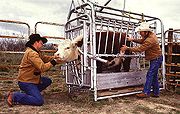
Cattle crushes may be fully fixed or mobile; however, most crushes are best classified as semipermanent, being potentially movable but designed to primarily stay in one place. A cattle crush is typically linked to a cattle race
Cattle race
A cattle race also called a run or alley is a narrow corridor built for cattle, sheep, pigs and other animals to travel through when being moved from one location to another that is nearby...
(also known as an alley). The front end has a head bail (or neck yoke or head gate) to catch the animal and may have a baulk gate that swings aside to assist in catching the beast. The bail is often adjustable to accommodate animals of different sizes. This bail may incorporate a chin or neck bar to hold the animal's head still. A side lever operates the head bail to capture the animals, with the better types having a rear drop-away safety lever for easier movement of the cattle into the bail. Usually, smaller animals can walk through the head bails incorporated in crushes.
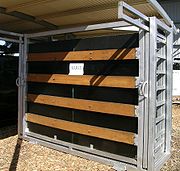
Artificial insemination
Artificial insemination, or AI, is the process by which sperm is placed into the reproductive tract of a female for the purpose of impregnating the female by using means other than sexual intercourse or natural insemination...
or pregnancy testing is being performed, or for other uses. Older crushes can also be found to have a guillotine gate that is also operated from the side via rope or chain where the gate is raised up for the animal to go under upon entering the crush, and then let down behind the animal.
A crush is a permanent fixture in slaughterhouse
Slaughterhouse
A slaughterhouse or abattoir is a facility where animals are killed for consumption as food products.Approximately 45-50% of the animal can be turned into edible products...
s, because the animal is carried on a conveyor restrainer under its belly, with its legs dangling in a slot on either side. Carried in this manner, the animal is unable to move either forward or backward by its own volition.
Some mobile crushes are equipped with a set of wheels so they can be towed from yard to yard. A few of these portable crushes are built so the crush may also be used as a portable loading ramp. A mobile crush must incorporate a strong floor, to prevent the animal moving it by walking along the ground.
Crushes vary in sophistication, according to requirements and cost. The simplest are just a part of a cattle race (alley) with a suitable head bail. More complex ones incorporate features such as automatic catching systems, hatches (to gain access to various parts of the animal), winch
Winch
A winch is a mechanical device that is used to pull in or let out or otherwise adjust the "tension" of a rope or wire rope . In its simplest form it consists of a spool and attached hand crank. In larger forms, winches stand at the heart of machines as diverse as tow trucks, steam shovels and...
es (to raise the feet or the whole animal), constricting sides to hold the animal firmly (normal in North American slaughterhouses), a rocking floor to prevent kicking or a weighing mechanism.
Specialist crushes
.jpg)
Highland cattle
Highland cattle or kyloe are a Scottish breed of beef cattle with long horns and long wavy coats which are coloured black, brindled, red, yellow or dun....
or Texas Longhorn cattle) are low-sided or very wide, to avoid damage to the horns. Other specialist crushes include those for tasks such as automatic scanning, foot-trimming or clipping the hair under the belly, and smaller crushes (calf cradles) for calves.
Standing stocks for cattle and horses are more commonly stand-alone units, not connected to races (alleys) except for handling animals not accustomed to being handled. These stand-alone units may be permanent or portable. Some portable units disassemble for transport to shows and sales. These units are used during grooming and also with veterinary procedures performed with the animal standing, especially if it requires heavy sedation, or to permit surgery under sedation rather than general anesthesia. For some surgical procedures, this is reported to be efficient, These units also are used during some procedures that require a horse to stand still, but without sedation.
There are two different types of specialised crushes used in rodeo
Rodeo
Rodeo is a competitive sport which arose out of the working practices of cattle herding in Spain, Mexico, and later the United States, Canada, South America and Australia. It was based on the skills required of the working vaqueros and later, cowboys, in what today is the western United States,...
arenas. Those for the "rough stock" events, such as bronc riding
Bronc riding
Bronc riding, either saddle bronc or bareback bronc competition, is a rodeo event that involves a rodeo participant riding on a horse , that attempts to throw or buck off the rider...
and bull riding
Bull riding
Bull riding refers to rodeo sports that involve a rider getting on a large bull and attempting to stay mounted while the animal attempts to buck off the rider....
, are known as bucking chutes or rough-riding chutes. For events such as steer roping
Steer roping
Steer roping, also known as steer tripping, is a rodeo event that features a steer and one mounted cowboy.The steer roper is behind a taut rope fastened with an easily broken string which is fastened to the rope on the steer. When the roper is ready he calls for the steer and the chute man trips a...
, the crush is called a roping chute. The rough-riding chutes are notably higher in order to hold horse
Horse
The horse is one of two extant subspecies of Equus ferus, or the wild horse. It is a single-hooved mammal belonging to the taxonomic family Equidae. The horse has evolved over the past 45 to 55 million years from a small multi-toed creature into the large, single-toed animal of today...
s and adult bulls, and have platforms and rail spacing that allows riders and assistants to access the animal from above. These chutes release the animal and the rider through a side gate. A roping chute is large enough to contain a steer of the size used in steer wrestling
Steer wrestling
Steer wrestling, also known as bulldogging, is a rodeo event in which a horse-mounted rider chases a steer, drops from the horse to the steer, then wrestles the steer to the ground by twisting its horns. Like all rodeo events, there are concerns from the animal rights community that the competition...
and may have a seat above the chute for an operator. The steer or calf is released through the front of the chute.
Hoof trimming crush
A hoof trimming crush, also called a hoof trimming chute or hoof trimming stalls, is a crush specifically designed for the task of hoof trimming on cattle. Such crushes range from simple standing frameworks to highly complex fixed or portable devices where much or all of the process is mechanised.History
Many cattle producers managed herds with nothing more than a race (alley) and a headgate (or a rope) until tagging requirements and disease control necessitated the installation of crushes.In the past the principal use of the crush, in England also known as a trevis, was for the shoeing of oxen
Ox
An ox , also known as a bullock in Australia, New Zealand and India, is a bovine trained as a draft animal. Oxen are commonly castrated adult male cattle; castration makes the animals more tractable...
. Crushes were, and in places still are, used for this purpose in North America and in many European countries. They were usually stand-alone constructions of heavy timbers or stone columns and beams. Some were simple, without a head bail or yoke, while others had more sophisticated restraints and mechanisms; a common feature is a belly sling which allows the animal to be partly or wholly raised from the ground. In Spain, the crush was a village community resource and is called potro de herrar, or "shoeing frame". In France it is called travail à ferrer (plural travails, not travaux) or "shoeing trevis", and was associated with blacksmith
Blacksmith
A blacksmith is a person who creates objects from wrought iron or steel by forging the metal; that is, by using tools to hammer, bend, and cut...
shops. Although the word travail derives from Latin tripalium, "three beams", all surviving examples but that at Roissard
Roissard
Roissard is a commune in the Isère department in south-eastern France....
have four columns. In central Italy it is called a travaglio, but in Sardinia
Sardinia
Sardinia is the second-largest island in the Mediterranean Sea . It is an autonomous region of Italy, and the nearest land masses are the French island of Corsica, the Italian Peninsula, Sicily, Tunisia and the Spanish Balearic Islands.The name Sardinia is from the pre-Roman noun *sard[],...
is referred to as , or "the machine for shoeing the oxen". In the United States it was called an ox sling, an ox press or shoeing stalls. In some countries, including the Netherlands and France, horses were commonly shod in the same structures. In the United States similar but smaller structures, usually called horse shoeing stocks, are still in use, primarily to assist farriers in supporting the weight of the horse's hoof and leg when shoeing draft horse
Draft horse
A draft horse , draught horse or dray horse , less often called a work horse or heavy horse, is a large horse bred for hard, heavy tasks such as ploughing and farm labour...
s.
External links
- Beef cattle yards for less than 100 head (5th ed)
- Circular cattle yard - 250 head capacity (2nd ed)
- British supply company sales page, illustrating various types of crush
- Australian supply company illustrating further types
- Australian company illustrating cattle crushes using doubly symmetric steel tubing

